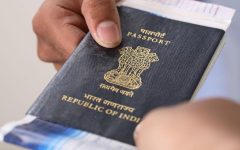Mobility Or Mortality: Rethinking Safety on Indian Roads
July 21, 2025 2025-07-21 9:43Mobility Or Mortality: Rethinking Safety on Indian Roads

Mobility Or Mortality: Rethinking Safety on Indian Roads
Abstract
Road accident fatalities in India are an ever-growing concern. This opinion piece analyses the factors driving this issue and critically assesses the role of broader systems in addressing them. It challenges the narrow framing of accidents as mere driver error and calls for a more holistic approach to road safety that includes thoughtful infrastructure design, accountable vehicle manufacturing standards, and equitable access to emergency care. Drawing from global and domestic best practices, the piece advocates for people-focused policies that offer a clearer, more inclusive path to safe mobility.
Introduction
When we think about Indian roads, what do we see? Congested roads, speeding vehicles, the incessant cacophony of cars and people. Our roads enrage us. But who are we angry at? Overcrowded buses, pedestrians darting across roads, or bikers cutting through traffic. It is ironic how roads, designed to ease movement, have hampered our right to safe mobility. We have become
so desensitized to everyday dangers that even our children routinely jaywalk on their way home from school, unaware of the risks. Too many names have become numbers buried in reports we don’t care to read. How long until it is one of us? Road accidents seem to have become an inescapable reality of daily life. Somewhere along the way, we have grown numb to our responsibilities. In 2022, the country recorded 4,61,312 road accidents, resulting in 1,68,491 fatalities. This is a 9.4% increase in accident-related deaths compared to 2021, a sudden hike from the decadal decline of 0.3% in 2020 (MORTH 2022). The major cause of the rising fatality rate is overspeeding, accounting for 71.2% of deaths. Other dangerous behaviors, such as drunken driving, driving on the wrong side, jumping red lights, and using mobile phones, collectively led to a 28.3% increase in deaths in 2022 (MORTH 2022). The numbers clearly suggest that Overspeeding behaviour must be assessed because there are multiple parameters to be considered. It is influenced by heterogeneous traffic conditions, spatial and temporal factors, even social dynamics.
The Cost of Speed-
These behaviours are aggravated by the vehicles we drive. On Indian roads, speed costs lives. The way we engineer our vehicles must be matched by how thoughtfully we design our roads. Speed is not a measure of progress, inclusivity and safety for all is. In 53 major cities across India, over- speeding was responsible for 51.5% of all road accident deaths in 2022 (MORTH 2022). A Study carried out in Mumbai showed that road design can play a significant role in curbing overspeeding. For instance, increasing the number of lanes reduces overspeeding by 3.26%, while improving road connectivity decreases it by 1.12% (CSE 2023). Conversely, arterial roads see more overspeeding, emphasizing the need for speed-calming measures like humps, rumble strips, and
stricter enforcement through speed cameras and penalties. It is also suggested for future policies to ensure infrastructure of fully controlled pedestrian access for drivers to become more vigilant of their overspeeding behaviours in such spaces.

Source: https://www.kgs.live/current-affairs/daily-current-affairs/2024-09-12/india-status-report-on-
The Motor Vehicles (Amendment) Act, 2019 enacted by the Parliament aims to tackle such a crisis by enforcing stricter penalties and leveraging compliance of traffic rules through technology
(Government of India 2019). A total of 23.92 crore e-challans amounting to Rs.36703.96 crore have been issued in the country for violation of traffic rules during the period from 25 September, 2020 to 7th December, 2024 (MORTH 2024 But can the fear of fines and penalties alone truly ensure compliance with traffic regulations? There is a need to address deeper systemic flaws that may be encouraging such behavior. There is a lack of transparency as to how the road safety funds are being utilized. Manufacturers often prioritize profits over safety, resulting in vehicles that undermine the vision of sustainable and secure mobility. In India, express highways are designed for maximum speeds of 120-150 km/hr for cars but automobile makers are allowed to produce vehicles capable of speeds of 200-250 km/hr (Global NCAP 2023). This crisis is not specific to India. Nearly 80 countries lack any laws regulating vehicle safety standards, leaving millions vulnerable to preventable accidents. However, vehicle safety standards must also consider the effects vehicles have on each other during collisions while performing vehicle crash tests. While SUV occupants are protected by the size and mass of their vehicles, this often comes at the cost of increased danger for those in smaller cars during collisions. Studies show that smaller cars bear the brunt of collisions, with fatality risks increasing up to eightfold when compared to larger vehicles (IIHS 2020). Therefore, manufacturers must cater to strict accident compatibility norms in order to mitigate risks faced by all road users in case of an accident. What matters is not just the occupant’s safety, but whether a vehicle is safe for all road users. It inadvertently inhibits a culture of exclusion where safety is warranted to only those who can afford it. This challenge is further amplified by increased motorisation with newly registered vehicles amounting to a Compound Annual Growth Rate (CAGR) of 9.83 percent between 2010 and 2020 (MoSPI 2021). With these developments, it may also be more pragmatic to invest in public
transport infrastructure and Emergency medical assistance to reduce the likely future increase in road incidents and fatalities, than attempting to achieve reductions in accident numbers.
Is it the driver’s fault?-
The enforcement of road safety norms is more complex than it appears. Who is truly to blame- the citizen, the institution or the manufacturer? Although 78% of road accidents are officially blamed on driver error, one must ask—what about the systemic failures, like ambulances arriving too late? Rural India suffered a staggering share of 68% of the road accident deaths (1,14,261 deaths) in 2022. The disproportionate number of deaths, in comparison to urban areas, emphasises on the critical need for adequate trauma care facilities along with other enforcement practices and awareness programs (MORTH 2022).
Global best practices-
Brunei, for instance, is one of the ten countries that have reduced their road accident numbers by 50% in the past decade. As part of their road safety strategies, the number of ambulances was increased annually to improve response times to road crashes and post-crash care (WHO 2023). The ‘Vision Zero’ policy in Sweden has successfully halved the number of road fatalities since the turn of the millennium. The policy prioritizes minimizing the fatal consequences of human error, aiming to protect both motorists and vulnerable road users. With only a 10% survival rate for pedestrians at 40mph, Sweden introduced an 18.6mph limit in built-up areas under Vision Zero. By 2020, 2,200 speed cameras ensured compliance after a comprehensive speed review (OECD/ITF 2021).
Kerala, paving its path toward safer roads, has made notable strides in road safety, achieving a 13.31% reduction in accidents and a 0.84% drop in fatalities. It has taken a decentralised approach to tackling its short term and long term road safety goals. It pioneered the Safe Corridor Demonstration Project, investing ₹146.6 crores on implementing best practices such as improving 33 junctions, gateway treatment in 36 school zones, solar lighting, road markings, sign boards and crash barriers in an 80 km stretch of one of the state’s most accident prone areas. Moreover, the World Bank has assisted the phase II of this program by allocating 4.0 million US dollars to the challenge fund which aims to implement best practices from the SCDP on road safety solutions at the district level (World Bank 2023).

Representational image of an under-construction road | Photo: Suraj Singh Bisht | ThePrint
Conclusion
To address the road safety crisis, we must first absorb the urgency of the problem. While it is not something that can be tackled without institutional engagement, individual awareness and empathy
paves way for change in stringent environments. he foundation of effective road safety lies in the ‘four E’s’: education, enforcement, engineering, and emergency care. Strengthening road safety management through coordinated efforts at local, state, and national levels can help streamline policies and enforcement. Vehicles must be equipped with the latest safety features and should adhere to vehicle safety standards. Educating all road users and fostering responsible behavior is key to minimizing human error, while a robust post-crash response system can save lives through timely medical interventions. Finally, creating safer driving environments by redesigning roads to accommodate pedestrians, cyclists, and motor vehicles alike will promote inclusivity and reduce risks for all road users.
Safer roads require collective responsibility among all stakeholders involved. It is crucial to focus on evidence based solutions, and stick to the basics- Education, Engineering, Enforcement and Emergency medical care. No one should have to risk their life simply to travel for work, education, or leisure.
Biblography
Centre for Science and Environment. (2023). CSE analysis of road design and speed patterns in Mumbai. https://www.cseindia.org/cse-analysis-of-road-design-and-speed-patterns-in-
Global NCAP. (2023). India vehicle safety assessment report. https://www.globalncap.org/india
Government of India. (2019). The Motor Vehicles (Amendment) Act, 2019. Ministry of Law and Justice. https://egazette.nic.in/WriteReadData/2019/210413.pdf
Insurance Institute for Highway Safety. (2020). Crash compatibility and vehicle size. https://www.iihs.org/topics/vehicle-size-and-weight
Ministry of Road Transport and Highways. (2022). Road accidents in India – 2022. Government of India. https://morth.nic.in/sites/default/files/RA_2022.pdf
Ministry of Road Transport and Highways. (2024). E-challan and penalty collection report (2020– 2024). Government of India. https://echallan.parivahan.gov.in
Ministry of Statistics and Programme Implementation. (2021). Transport statistics of India 2021.
Government of India. https://mospi.gov.in
Organisation for Economic Co-operation and Development/International Transport Forum. (2021). Sweden: Road safety annual report. https://www.itf-oecd.org/road-safety-annual-
World Bank. (2023). Safe Corridor Demonstration Project: Kerala, India. https://www.worldbank.org/en/news/feature/2023/06/15/kerala-road-safety-initiative
World Health Organization. (2023). Global status report on road safety 2023. https://www.who.int/publications/i/item/9789240076638
About the author
Raarya Priyadarsini Kuanr is a second-year Masters student in Public Policy at OP Jindal Global University. Her policy interests span urban governance, public transportation, critical perspectives on science and technology, smart cities, Informal economies and displacement of marginalized people Outside academia, she is passionate about sports particularly basketball and boxing and is currently relearning the joy of reading and writing in an age of constant digital acceleration.






